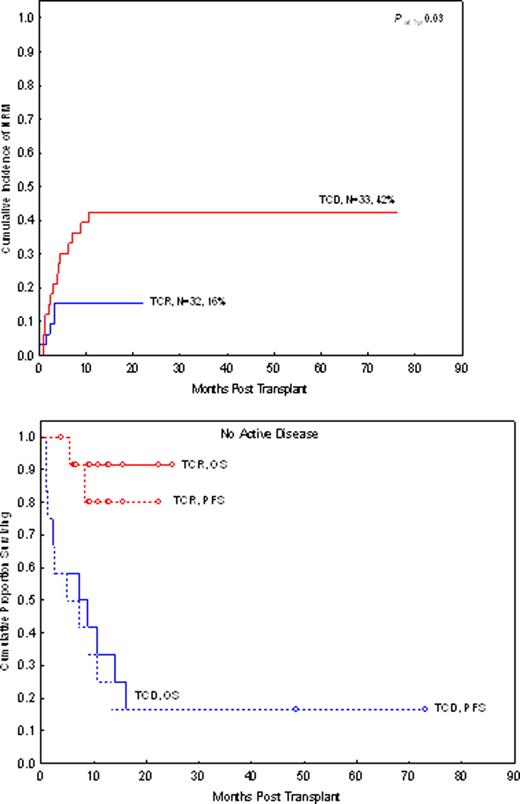Abstract
HaploSCT has been commonly performed with a TCD graft using CD34+ selection; however, this has been limited by a higher non-relapse mortality (NRM) primarily related to infectious complications. An alternative approach using a TCR bone marrow graft and high-dose post-transplant cyclophosphamide (HDPTCy) in the setting of non-myeloablative conditioning has been reported to have lower NRM and acceptable rates of GVHD.
We hypothesized that TCR HaploSCT using HDPTCy is associated with improved immunologic reconstitution, less NRM and better early outcomes compared with TCD HaploSCT, and analyzed 65 consecutive patients (pts) treated at UTMDACC with the same conditioning regimen, fludarabine (40mg/m2/day × 4), melphalan (140mg/m2) and thiotepa (10mg/kg). TCD HaploSCT pts were treated between 2001 and 2009, while TCR patients after 2009. 6 pts in the TCR group >55 years/comorbidities received reduced doses of melphalan (100mg/m2) and thiotepa (5mg/kg). There was no GVHD prophylaxis in the TCD group, while TCR group received HDPTCy (50mg/kg/day × 2) followed by tacrolimus and mycophenolate.
The median follow-up was 10 months (range 3.5–25) for the TCR group and 44 (11–79) months for the TCD group. Median age was 45 years (range 20–63) in the TCR group and 36 years (range 18–56) in the TCD group (p=0.02). 28% were > 50 years in the TCR compared with 6% in the TCD group (p=0.02). Diagnoses were: AML/MDS 50% vs. 79%, ALL 13% vs. 12%, CML 16% vs. 6%, lymphoma/CLL 9% vs. 3% in the TCR vs. TCD groups, respectively. Only 13 (41%) and 12 (36%) of pts were in remission at transplant in both groups, respectively (p=0.7). 10/16 (62.5%) pts with AML/MDS in the TCR group had poor risk cytogenetics vs. 13/26 (50%) pts in the TCD group. The donors were 5/10 allele match in 20/32 (63%) and 16/31 (52%) in the two groups, respectively. Median numbers of CD34+ cells infused were 2.5×10e6/kg in the TCR group and 10.5×10e6/kg in the TCD group. All pts in the TCD group had peripheral blood selected CD34+ cells while all but one received bone marrow stem cells in the TCR group.
One pt had early death in each group. Primary engraftment was achieved in 94% in the TCR group and 81% in the TCD group (p=0.1). Day-100 NRM for all pts was 9% in the TCR group vs. 21% for the TCD group, and for pts in remission at transplant 0% vs. 42%, respectively (p=0.01). NRM at 1 year for all pts was 16% for the TCR group vs. 42% for the TCD group (p=0.03) (Figure1), while for pts in remission was 0% vs. 67% (p=0.001). The cumulative incidences of grade II-IV aGVHD was 27% vs. 11% (p=0.5) and cGVHD was 8% vs. 18%, in the TCR and TCD group, respectively (p=0.03). OS and PFS at 1 year post-transplant were 66% vs. 30% (p=0.02) and 45% vs. 21% (p=0.03) for the whole group, and 92% vs. 33% (p=0.03) and 80% vs. 25% (p=0.02) for pts in remission at transplant, respectively (Figure1).
Cumulative incidence of NRM for all pts (left) and OS and PFS for pts in remission at transplant (right) treated with TCD and TCR HaploSCT.
Cumulative incidence of NRM for all pts (left) and OS and PFS for pts in remission at transplant (right) treated with TCD and TCR HaploSCT.
Improved NRM in the TCR group was related to significantly better immunologic reconstitution of T-cell subsets. On day 30 post transplant there was a significantly better recovery of absolute CD4 cells in the TCR group (median 24 vs. 2, p=0.004) and CD8 cells (median 20.5 vs. 1.5, p=0.036). CD4 cells remained significantly lower in the TCD group until after day 180 when the median CD4 count was 200.5 vs. 64 in the TCR group (p=0.04) while the difference in CD8 counts became non-significantly higher in the TCR after day 90 (median 119 vs. 29, p=0.23).
TCR HaploSCT is associated with better immunologic reconstitution and improved early outcomes compared with TCD HaploSCT.
No relevant conflicts of interest to declare.

This icon denotes a clinically relevant abstract
Author notes
Asterisk with author names denotes non-ASH members.


This feature is available to Subscribers Only
Sign In or Create an Account Close Modal